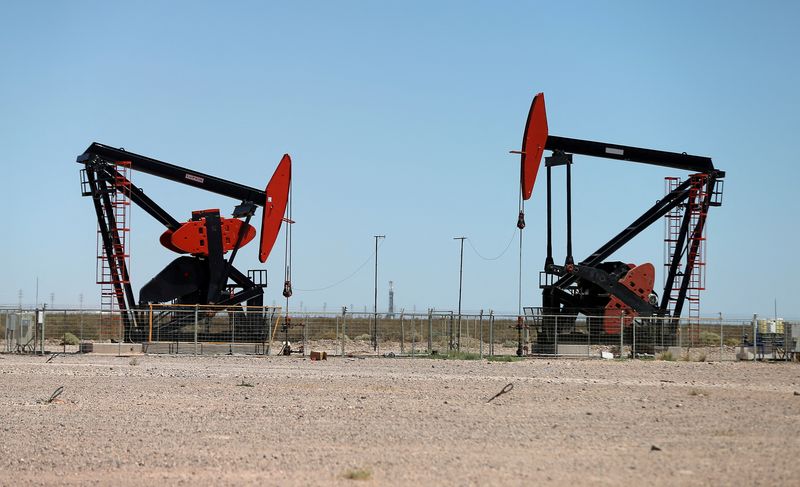Commodities
Oil up 1.5% as Saudi Arabia and Russia stick to supply cuts


© Reuters. FILE PHOTO: Oil pump jacks are seen at the Vaca Muerta shale oil and gas deposit in the Patagonian province of Neuquen, Argentina, January 21, 2019. REUTERS/Agustin Marcarian/File Photo
By Robert Harvey
LONDON (Reuters) -Oil prices rose on Monday after top exporters Saudi Arabia and Russia reaffirmed their commitment to extra voluntary oil supply cuts until the end of the year.
futures rose $1.25, or 1.47%, to $86.14 a barrel by 1145 GMT. U.S. West Texas Intermediate crude was up $1.29, or 1.6%, at $81.80.
Oil was rebounding after both benchmarks lost about 6% in the week to Nov. 3.
Saudi Arabia confirmed on Sunday it would continue with its additional voluntary cut of 1 million barrels per day (bpd) in December to keep output around 9 million bpd, a ministry of energy source said.
Russia also announced it would continue its additional voluntary cut of 300,000 bpd from its and petroleum product exports until the end of December.
The cuts could be extended into the first quarter of 2024 because of “seasonally weaker oil demand at the start of every year, ongoing economic growth concerns and the aim of producers and OPEC+ to support the oil market’s stability and balance”, said UBS strategist Giovanni Staunovo.
Investors will be watching for further economic data from China on Tuesday after weak October factory data last week.
Analysts expect a 3.3% year-on-year fall in exports in October, a Reuters poll showed, slowing from a 6.2% decline in September.
Monday’s oil price gains could have been capped by an easing of crude throughput at Chinese refineries.
Refinery runs are easing from record levels in the third quarter because of eroding profit margins and a scarcity of export quotas to the end of the year, traders and industry consultants told Reuters.
“The reaction to the Saudi and Russian decisions over the weekend to extend their respective output and exports cuts throughout December has been, to some extent, countered by the anticipated fall in China’s refinery throughput this month,” said PVM analyst Tamas Varga.
Macroeconomic concerns persist in Europe, where Purchasing Managers’ Index (PMI) data showed the slowdown in euro zone manufacturing accelerated in October.
Commodities
Oil prices rise; U.S. crude inventories plunge, Russia-Ukraine truce eyed
Commodities
India’s Reliance to stop buying Venezuelan oil over US tariffs, sources say
Commodities
Oil prices climb on Venezuela supply worries

 Forex3 years ago
Forex3 years agoForex Today: the dollar is gaining strength amid gloomy sentiment at the start of the Fed’s week

 Forex3 years ago
Forex3 years agoUnbiased review of Pocket Option broker

 Forex3 years ago
Forex3 years agoDollar to pound sterling exchange rate today: Pound plummeted to its lowest since 1985

 Forex3 years ago
Forex3 years agoHow is the Australian dollar doing today?

 Cryptocurrency3 years ago
Cryptocurrency3 years agoWhat happened in the crypto market – current events today

 World3 years ago
World3 years agoWhy are modern video games an art form?

 Commodities3 years ago
Commodities3 years agoCopper continues to fall in price on expectations of lower demand in China

 Economy3 years ago
Economy3 years agoCrude oil tankers double in price due to EU anti-Russian sanctions























